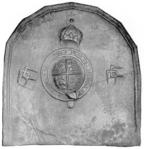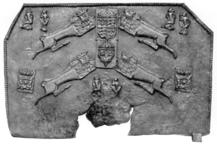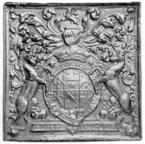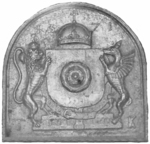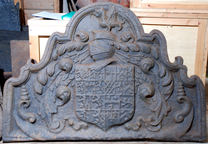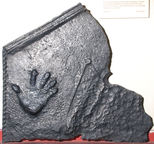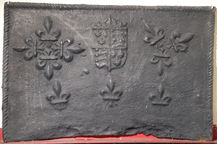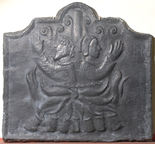-
266
Description: Arch-shaped, the arch consisting of eight, straight, ovolo-moulded sections; longer ovolo-moulded pieces form the lower sides of the fireback; in the centre a circular garter enclosing the Tudor arms of England; above, a crown; irregularly spaced each side of the shield, a crossed staple stamp (the left one over-pressed).
Notes: The crossed staple stamp suggests a connection with the Nevill family. The crown is formed from a separate stamp to the shield and garter. Other variants are dated 1589. Recorded at Penshurst Place in 1903; illustration from Dawson 1903.
Inscription: HONI SOIT qVI MAL I PANSE
Arms: Tudor royal
- Decoration tags:
- multi-facetted arch (shape)
- ovolo (edging)
- carved stamps
- heraldic
- armorial
- royal
Manufactured: in the late 16th century in the Weald area of England.
Current location:, not known.
Citation: Dawson, C., 1903, 'Sussex Iron Work and Pottery', Sussex Archaeological Collections, 46, pp. 1-54.
Citation: Gardner, J. S., 1898, 'Iron Casting in the Weald', Archaeologia, 56, 1, pp. 133-164.
- Attached to series:
- 1589 series
- Tudor royal armorial firebacks
-
267
Description: Rectangular; twisted rope edging (top and sides); top centre, crowned Tudor royal shield (over-pressed) between a leopard passant guardant sinister (on the left) and a leopard passant (on the right); below, crowned shield bearing initials, KH, above a fleur-de-lys, between two further leopards, styles as above; below the lower shield, two 'imp' figures, the left one with both arms lowered, the right with its right arm raised; outside each lower leopard, a crowned rose (over-pressed); each top corner, a pair of ‘imp’ figures styles as before.
Notes: One of the 'Royal' series. Illustration from Dawson 1903. Formerly in the collection of Dr C. Prince, of Crowborough, Sussex. Further deterioration at the bottom of the casting has caused some loss of metal.
Inscription: KH
Arms: Tudor royal arms of England
- Decoration tags:
- canted rectangular (shape)
- rope (edging)
- carved stamps
- heraldic
- armorial
- animals
- humans
- plants
Manufactured: in the mid 16th century in the Weald area of England.
Current location: Leeds Castle, Leeds, Kent, England.
Citation: Balcomb, J. T., Nov. 1886, 'An Extinct Sussex Art', The Art Journal, pp. 337-340.
Citation: Dawson, C., 1903, 'Sussex Iron Work and Pottery', Sussex Archaeological Collections, 46, pp. 1-54.
Citation: Gardner, J. S., 1898, 'Iron Casting in the Weald', Archaeologia, 56, 1, pp. 133-164.
- Attached to series:
- Royal series
-
268
Description: Rectangular; cavetto moulded edging; shield, garter, coronet, helm, crest, supporters and motto of Villiers, 1st Duke of Buckingham.
Notes: The arms are those of George Villiers (1592-1628), created Duke of Buckingham in 1623. Blazon: Quarterly 1, Villiers (modern) - argent, on a cross gules five scallops or; 2, Villiers (ancient) - sable, a fess between three cinquefoils argent; 3, Pakeman - gules, a chevron between three crosses botonnee fitchee argent; 4, Bellers - per pale gules and sable, a lion rampant argent crowned or; 5, Hoby - azure, a bend between six mullets argent; 6, Kirkby - argent, a cross between two annulets vert.
Copies of this fireback are known.
Inscription: HONI SOIT QVY MAL Y PENSE / FIDEI COTICULA CRUX [The cross is the touchstone of faith]
Arms: George Villiers, 1st Duke of Buckingham
- Decoration tags:
- rectangular (shape)
- cavetto (edging)
- whole carved pattern
- planklines
- armorial
Manufactured: in the early 17th century in England.
Current location:, not known.
Citation: Dawson, C., 1903, 'Sussex Iron Work and Pottery', Sussex Archaeological Collections, 46, pp. 1-54.
- Attached to series:
- Personal armorial firebacks
- Bristol armorial series
-
269
Description: Arched; cavetto edging; crowned plain shield bearing a Tudor rose, with crowned lion and dragon supporters, with garter and motto; date split by crown.
Notes: The numerals are more typically 16th century in form than are found on copies produced from the late-19th century (see no. 178), suggesting this may be the original design; illustration from Dawson (1903).
Inscription: 15 71 / T K; [English royal, and garter, mottoes].
- Decoration tags:
- arched (shape)
- cavetto (edging)
- whole carved pattern
- individual letters
- individual numbers
- heraldic
- royal
Manufactured: in 1571 in the Weald area of England.
Current location:, not known.
Citation: Dawson, C., 1903, 'Sussex Iron Work and Pottery', Sussex Archaeological Collections, 46, pp. 1-54.
- Attached to series:
- Miscellaneous royal firebacks
-
158
Description: Armorial within complex ovolo moulded edging on all sides; two plank lines; shield, helm, crest and mantling of the Trevor family; the achievement is distinguished by the elaborately festooned mantling, the whole resting on a boat-shaped compartment.
Notes: The arms, which are of an esquire, are probably those of John Trevor (c1652-1686), the son of Sir John Trevor, one of Charles II’s Secretaries of State. By his marriage in 1679 to Elizabeth (c1656-1693), widow of William Morley, of Glynde, Sussex, the Glynde Place estate passed into the hands of the Trevors. The arms on this fireback have been variously, but incorrectly, attributed to Lord Dacre (a descendant of John Trevor), and Col. Marcus Trevor, 1st Viscount Dungannon (peers' arms have supporters). The distinctive shape is seen in similar form on several other armorial firebacks over the preceding century, suggesting a continuity of pattern making, if not the same pattern maker. Many copies of this fireback exist.
Copies of this fireback are known.
Arms: Trevor family, of Glynde
- Decoration tags:
- complex quasi-arched rectangular (shape)
- ovolo (edging)
- whole carved pattern
- planklines
- armorial
Manufactured: in the late 17th century in the Weald area of England.
Current location: Hastings Museum and Art Gallery, John's Place, Bohemia Road, Hastings, East Sussex, England.
Museum number: HASMG: 1917.2 (part of the Hastings Museum museum group)
Citation: Baines, J. M., 1958, Wealden Firebacks (Hastings Museum).
Citation: Dawson, C., 1903, 'Sussex Iron Work and Pottery', Sussex Archaeological Collections, 46, pp. 1-54.
Citation: Straker, E., 1931, Wealden Iron (London, Bell).
- Attached to series:
- Ornate border series
- Personal armorial firebacks
- Welsh armorial firebacks
-
370
Description: Fragment; left side only; twisted rope edging to left, canted moulded batten above; left hand print with dividers to its right.
Notes: An unusual combination of edging. The dividers may refer to the occupation of the person for whom this fireback was cast. Formerly in the collection of Dr C. L. Prince of Crowborough, Sussex.
- Decoration tags:
- canted rectangular (shape)
- rope and wood moulding (edging)
- simple stamps
- humans
- objects
Manufactured: in the mid to late 16th century in the Weald area of England.
Current location: Anne of Cleves House, Southover High Street, Lewes, East Sussex, England.
Museum number: LH000.798 (part of the Sussex Archaeological Society museum group)
Citation: Anon., 30 Dec 1911, 'Sussex Backs and their Story', The Ironmonger.
Citation: Dawson, C., 1903, 'Sussex Iron Work and Pottery', Sussex Archaeological Collections, 46, pp. 1-54.
Citation: Gardner, J. S., 1898, 'Iron Casting in the Weald', Archaeologia, 56, 1, pp. 133-164.
- Attached to series:
- Hand print firebacks
- Metalware stamp firebacks
-
384
Description: Rectangular; twisted rope edge on top and sides; crowned Tudor royal shield between fleurs de lys arranged in a four-pointed star shape on left, in a three-pointed star shape on right, and three singly in a line below.
Notes: The crowned shield is seen on several firebacks, indicating that they were products of the same furnace.
Arms: Tudor royal arms of England
- Decoration tags:
- rectangular (shape)
- rope (edging)
- carved stamps
- heraldic
- armorial
Manufactured: in the mid 16th century in the Weald area of England.
Current location: Anne of Cleves House, Southover High Street, Lewes, East Sussex, England.
Museum number: 1944.24.034 (part of the Sussex Archaeological Society museum group)
Citation: Dawson, C., 1903, 'Sussex Iron Work and Pottery', Sussex Archaeological Collections, 46, pp. 1-54.
- Attached to series:
- Royal series
-
386
Description: Rectangular; twisted rope edging on top and sides; date placed centrally near top.
Notes: A similar fireback with slightly different proportions has the same date using the same numerals. Formerly at the Anchor Hotel, Eastbourne, Sussex.
Inscription: 1679
- Decoration tags:
- rectangular (shape)
- rope (edging)
- carved stamps
- individual numbers
- text
Manufactured: in 1679 in the Weald area of England.
Current location: Anne of Cleves House, Southover High Street, Lewes, East Sussex, England.
Museum number: LH000.910 (part of the Sussex Archaeological Society museum group)
Citation: Dawson, C., 1903, 'Sussex Iron Work and Pottery', Sussex Archaeological Collections, 46, pp. 1-54.
- Attached to series:
- Date only firebacks
- 1679 Wealden series
-
393
Description: Rectangular with canted top corners; twisted rope edging all round except base: plain plate with two stamps of an iron firedog with twisted neck and shield bearing letters HN and crossed staples; firedogs have columnar capitals; fleur de lys stamp repeated six times, singly at each end, in star pattern in middle; stamps have twisted wreaths.
Notes: The initials HN probably refer to Henry Nevill, the crossed staples being a badge of the Nevill family. Henry Nevill occupied Mayfield furnace from about 1585 until 1599. One of two variants (see no. 742) with the same firedogs and fleurs-de-lys; other firedogs in a very similar style are known. Formerly at Holmbush Farm, Hellingly, Sussex.
Inscription: HN HN
- Decoration tags:
- canted rectangular (shape)
- rope (edging)
- simple stamps
- carved stamps
- heraldic
- text
- objects
Manufactured: in the late 16th century possibly at Mayfield Furnace in the Weald area of England.
Current location: Anne of Cleves House, Southover High Street, Lewes, East Sussex, England.
Museum number: LH000.902 (part of the Sussex Archaeological Society museum group)
Citation: Anon., 30 Dec 1911, 'Sussex Backs and their Story', The Ironmonger.
Citation: Dawson, C., 1903, 'Sussex Iron Work and Pottery', Sussex Archaeological Collections, 46, pp. 1-54.
Citation: Gardner, J. S., 1898, 'Iron Casting in the Weald', Archaeologia, 56, 1, pp. 133-164.
- Attached to series:
- Henry Nevill series
- Firedog stamp firebacks
- Metalware stamp firebacks
-
396
Description: Cavetto-canted rectangle with arched top; astragal and cavetto edging (top and sides); pictorial; back-to-back figures of a bearded man and a woman in a poke bonnet, both dressed in tunics, their arms raised, respectively left and right; they are chained to a vertical pole; below, flames issue from vertically stacked logs, while smoke rises above them; the physical proportions of the figures are naïve, the man’s eyes being over-large, as are the hands of both.
Notes: The design is a free adaptation of an illustration from The Book of Martyrs by John Foxe (1563), a copy from a back originally noted at Brick Cottage, Burwash, Sussex, in 1871. This may be the design of fireback referred to in an enquiry printed in the St James's Chronicle, or British Evening Post, of 9 August 1788, which described it as 'having two Bishops burning at Stakes thereon' at a house in Warwickshire. At an auction sale in 2017 the same design of fireback was interpreted as the burning of Bishops Latimer and Ridley in 1555. Protestants were burnt to death at several Wealden locations as well as elsewhere in the south-east of England during the reign of Mary I, notably at Canterbury and Lewes. The subject of the fireback should be regarded as symbolic rather than commemorating any individual martyrs.
Copies of this fireback are known.
- Decoration tags:
- cavetto-canted arched rectangular (shape)
- astragal with cavetto (edging)
- whole carved pattern
- pictorial
- historical
- humans
Manufactured: in the late 16th to early 17th century in the Weald area of England.
Current location: Anne of Cleves House, Southover High Street, Lewes, East Sussex, England.
Museum number: LH000.903 (part of the Sussex Archaeological Society museum group)
Citation: Butterfield, W. R., 1916, 'Old Wealden Firebacks', The Connoisseur, 46, pp. 197-209.
Citation: Dawson, C., 1903, 'Sussex Iron Work and Pottery', Sussex Archaeological Collections, 46, pp. 1-54.
Citation: Paine, C., Aug 2013, 'Mystery of the Two Martyrs', Sussex Past and Present, 130, pp. 6-7.
Citation: Straker, E., 1931, Wealden Iron (London, Bell).
- Attached to series:
- Commemorative firebacks
